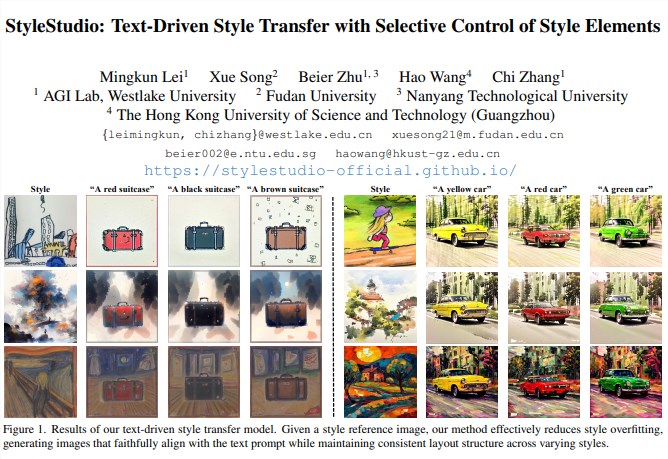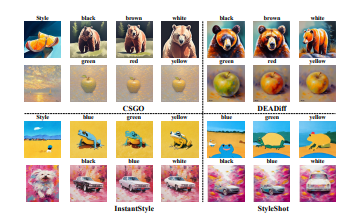This article explores recent advances in text-driven image style transfer technology and the challenges it faces. In recent years, text-to-image generative models have made significant progress, enabling more refined style transfer, but problems such as style overfitting, inaccurate text alignment, and generation artifacts still exist. In order to solve these problems, the researchers proposed three complementary strategies, including AdaIN-based cross-modal fusion, style-based classifier-free guidance (SCFG), and using teacher models for layout stabilization, and verified their effectiveness through experiments, showing that This significantly improves the quality of generated images and their consistency with textual cues.
Text-driven style transfer is an important task in the field of image synthesis, aiming to blend the style of a reference image with the content described by the text prompt. Recently, significant progress has been made in text-to-image generative models, enabling more refined style transfer while maintaining high content fidelity. This technology has huge practical value in areas such as digital painting, advertising and game design.

However, existing style transfer techniques still have some shortcomings. The main challenges include:
Style overfitting: Existing models tend to copy all elements of the reference image, causing the generated image to be too close to the characteristics of the reference style image, limiting the aesthetic flexibility and adaptability of the generated image.
Inaccurate text alignment: The model may prioritize the dominant color or pattern of the reference image, even if these elements contradict the instructions in the text prompt.
Generating artifacts: Style transfer can introduce unwanted artifacts, such as recurring patterns (such as a checkerboard effect) that disrupt the overall layout of the image.

To address these issues, the researchers proposed three complementary strategies:
AdaIN-based cross-modal fusion: Utilize the Adaptive Instance Normalization (AdaIN) mechanism to integrate style image features into text features, and then fuse them with image features. This adaptive blend creates a more cohesive guidance signature, aligning style features more harmoniously with text-based instructions. AdaIN effectively integrates style into content by adjusting content characteristics to reflect style statistics, while retaining the consistency of content and text description.
Style-based classifier-free guidance (SCFG): Develop a style guidance method that focuses on the target style and reduces unnecessary style features. By using a layout-controlled generative model (e.g. ControlNet), a "negative" image is generated that lacks the target style. This negative image acts like an "empty" cue in the diffusion model, allowing the guide to focus entirely on the target style element.
Layout stabilization using teacher models: Introduce teacher models in the early stages of generation. The teacher model is based on the original text-to-image model, performs denoising generation with the same text cues simultaneously with the style model, and shares its spatial attention map at each time step. This method ensures a stable and consistent spatial distribution, effectively mitigating issues such as checkerboard artifacts. Furthermore, it achieves a consistent spatial layout of the same text prompt across reference images of different styles.
The researchers verified the effectiveness of these methods through extensive experiments. The results show that this method can significantly improve the quality of style transfer of generated images and maintain consistency with text cues. More importantly, the method can be integrated into existing style transfer frameworks without fine-tuning.
The researchers found through experiments that instability in the cross-attention mechanism can lead to the appearance of artifacts. The self-attention mechanism plays a key role in maintaining the layout and spatial structure of images by capturing high-level spatial relationships to stabilize the basic layout during generation. By selectively replacing certain self-attention maps in a stylized image, the spatial relationships of key features in the image can be preserved, ensuring that the core layout remains consistent throughout the denoising process.
Furthermore, style-based classifier-free guidance (SCFG) effectively solves the problem of style ambiguity by selectively emphasizing desired style elements while filtering out irrelevant or conflicting features. This approach mitigates the risk of overfitting irrelevant style components by using a layout-controlled model to generate negative style images, allowing the model to focus on transmitting the desired style components.
The researchers also performed ablation experiments to evaluate the impact of each component. The results show that both AdaIN-based cross-modal fusion and teacher models can significantly improve the accuracy of text alignment, and they have complementary effects.
In summary, the method proposed in this study can effectively alleviate the style overfitting and layout instability problems existing in existing text-driven style transfer techniques, thereby achieving higher quality image generation and providing support for text-to-image synthesis tasks. A versatile and powerful solution.
Paper address: https://arxiv.org/pdf/2412.08503
This research provides an effective solution to the key challenges in text-driven image style transfer, bringing new breakthroughs in the field of high-quality image generation and text-to-image synthesis. The research results have broad application prospects and deserve further in-depth study and exploration.